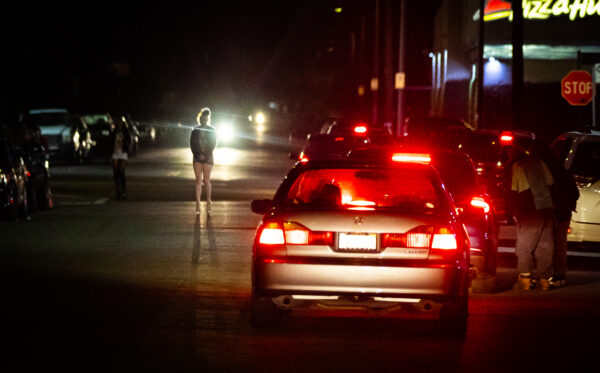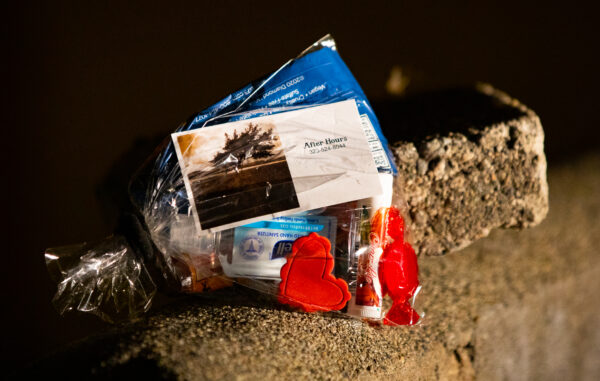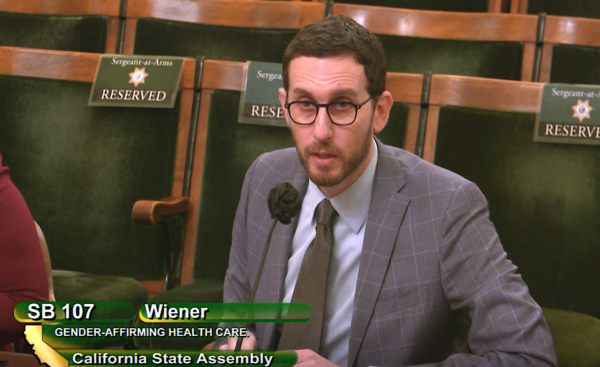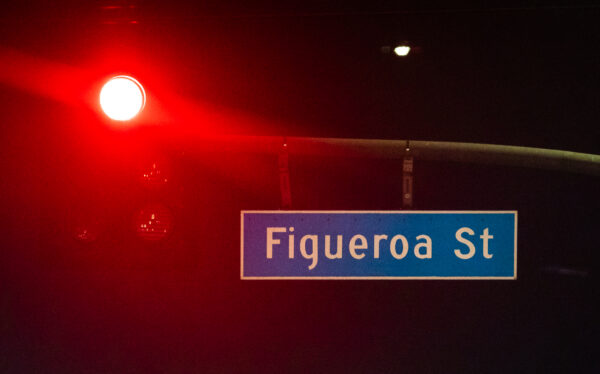

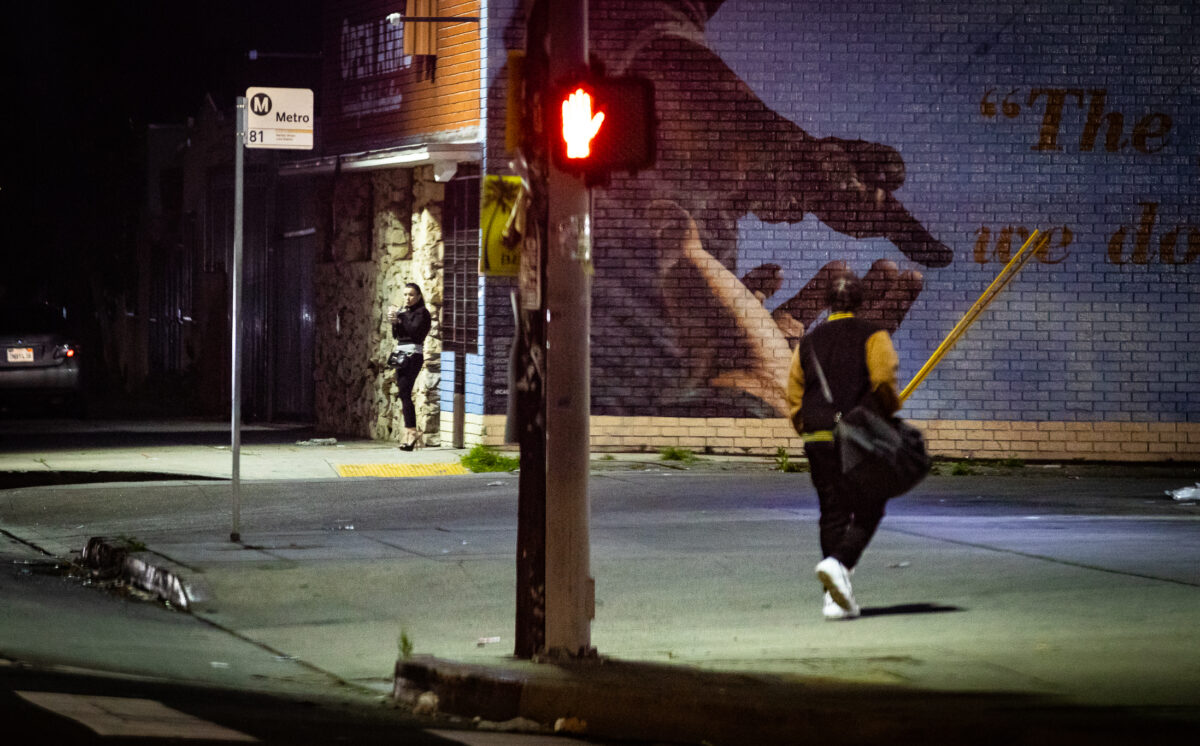
LOS ANGELES—At Figueroa and 69th Streets girls appearing as young as 15 stood in G-Strings and unbuttoned blouses, one Wednesday evening earlier this month, as cars idled in a small traffic jam under the weak glow of faded street lights.
Even on a weeknight, Los Angeles’s busiest area for sex work—known colloquially as “The Blade”—has smiling men with their car windows down shopping for women and girls.
In this South LA neighborhood, outreach groups say, young women and underage teens are encouraged to solicit sex for profit by the overwatch of their pimps.
“A ‘John Jam’ is like a traffic jam but with people lined up to buy the girls for sex,” Mari Clark—with the After-Hours Ministry, a Christian organization working to help victims of sexual exploitation—told The Epoch Times from the passenger seat of a van the organization uses to help prostitutes in the area.
“On the weekends [they] happen much more frequently and it can take up to 20 minutes just to drive down a small block of houses,” she said.
On this particular Wednesday evening—around 10:30 p.m.—two women with the ministry were handing out small gift bags that contained hand sanitizer, mints, hand warmers, chapstick, and their business cards. They also provided snacks and water bottles, which most of the young prostitutes joyfully accepted.
“Thank you. I’ve been out for three hours already!” one early 20s Hispanic woman wearing fishnet stockings and shiny platform boots told ministry worker Tracy Speers.
The interaction gave Speers an opportunity to remind the young woman that the ministry is there if she needs it.
“You give us a call if you need any help, okay?” Speers told her. “We love you guys, and our business card is in the gift bag.”
Driving through the area, it’s hard not to miss that homes lining its narrow residential streets are clad with iron bars over their windows. Front porch lighting is scarce, as most residents keep to the back due to shootings and criminal activity.
Outreach workers familiar with the area say that some of the area’s pimps have purchased the homes—using names of the women over 18 working for them—and use them as their base of operation.
The pimps here operate in public view: sometimes slowly patrolling in their cars trailing loud rap music and pungent marijuana smoke while keeping an eye on their girls.
Their sex workers have even been branded of sorts: having their pimp’s name tattooed across their faces.
One pimp sat atop his vehicle watching all move along one narrow residential street. The glow of his phone revealed he wore sunglasses even in the darkness of the night.
“You need to keep the camera down. That guy will kill us if he sees it,” Speers told an Epoch Times journalist as the van drove past him.
The ministry workers doubled back to where they had been earlier to connect with a group of girls they had missed before. Again, they offered those they saw what they had on hand: hand warmers, this time, and some potato chips.
“No, I’m okay, thank you,” a girl who appeared to be no older than age 15 said. She was wearing a short plaid skirt and only a bra.
Nearby, her pimp, a middle-aged Black man in his car with its door ajar, watched.
Development of The Blade can be traced to the 1960s where access from the Port of Los Angeles to downtown along Figueroa and nearby streets gave way to an open-air sex market and provided a place for working class men commuting this stretch of roadway 24-hour access to prostitution.
Eventually, motels sprang up as did some small businesses and residential areas.
“I grew up near the area and remember seeing [prostitutes] during my high school days” in the 1970s, Dr. Stephany Powell, Vice of the National Center on Sexual Exploitation, told The Epoch Times.
“There were always girls there,” said Powell, who is the director of law enforcement outreach and training for the center. “But now is probably the worst I have seen.”
She said officers of the Los Angeles Police Department, where she previously held the position of sergeant, have told her they feel similarly.
One factor she says in more girls and women being exploited on The Blade and throughout some cities in California—is a recent new law in the state that repealed previous legislation that made it unlawful to loiter with the intent to commit prostitution: Senate Bill 357 authored by Sen Scott Wiener (D-San Francisco).
Though the bill was signed by Gov. Gavin Newsom last July, it only went into effect on Jan 1, 2023. But news of it spread quickly.
“As soon as Newsom signed it, you started to see an ‘uptick’ out there,” Powell said.
“The word on the street was … prostitution is legal … as of January 1st they can’t do anything for you if you are flagging down a car and all you have on is a G-string and panties.”
For Los Angeles police officers the repeal of loitering for prostitution has been noted as taking away a “major tool” especially when trying to crack down on those who buy sex from the streets.
“It is common for sex buyers to drive around high prostitution areas with no other lawful reason to be in the area,” Los Angeles Sheriff Department officials wrote in the Senate Floor Analysis for the bill. “While the intent of this legislation is to protect the prosecution of a vulnerable community, the unintended consequences will be to benefit the sex buyers as well.”
Where most high school aged girls in Los Angeles are preparing to shop for upcoming high school prom dresses, a girl of the same age on The Blade recently walked away from a potential sex buyer in little more than her underwear under the overwatch of a man pimping her for his own profit.
Her customer had a slight grin on his face as she walked away as two other prostitutes were waiting by his car to negotiate a deal for sex.
In a city where more than 50 percent of children who became sex trafficking victims were from the child welfare system, the average age entering prostitution is 12-13 years old according to Los Angeles government officials.
“I think that the issues at play in The Blade run so deeply, that I’m not really sure if either the City or County knows where to begin [because] it’s a daunting task that involves so many aspects of human life and would require vast amounts of resources,” a Los Angeles healthcare worker working closely with foster youth under the pseudonym Krista told The Epoch Times.
“That’s not to say that people in local government and in the community shouldn’t try. We absolutely should,” she said.
For Krista, as reports of more minors trapped in sex work on The Blade worsen, she said, she and others like her blame city leadership that is “soft on crime.”
“The political or cultural ideologies of those in power are reflected in policies and laws, which have real-life consequences for the citizens,“ she said.
But like Krista, fellow minded individuals who feel called by God to serve children and women trapped in prostitution on The Blade said they keep grounded by not “sugarcoating” the reality of what’s happening along one of Los Angeles’s most dangerous 10-city blocks.
“Keep in mind that hearts and minds would have to change,” Krista said. “Humans have free will and inevitably some will choose not to accept the help and continue in these patterns of abuse and crime that we see.”
Staff for California Gov. Gavin Newsom and Sen. Scott Wiener declined to comment.

